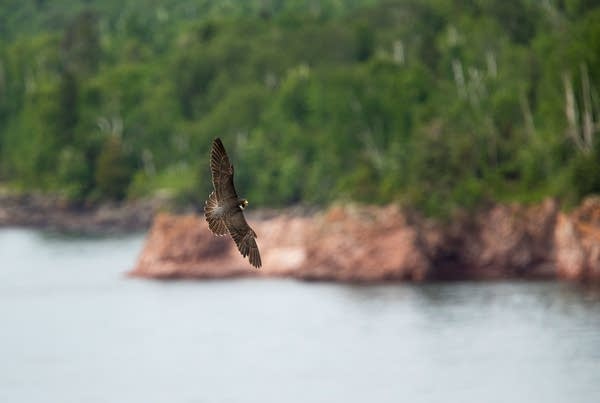Once-threatened peregrines flying high across Minnesota

Two adult peregrine falcons pestered climbers Mark Mussell and Cody Benz as they prepared to rappel down the cliff at Shovel Point, near the birds' nest in Tettegouche State Park. The birds flew by screeching, putting on high-speed aerobatic displays just feet from the climbers' heads.
It was a remarkable sight, considering the peregrine was wiped out in Minnesota in 1964, a victim of widespread use of the pesticide DDT after World War II.
"In less than 20 years' time they went from endangered to fully recovered," said Jackie Fallon, vice chair of field operations for the Midwest Peregrine Society. "And there is no other endangered species program worldwide that has had that amount of success in such a short time period."
Staff and volunteers at Tettegouche State Park, on Lake Superior's north shore, just wrapped up their peregrine banding program.
Create a More Connected Minnesota
MPR News is your trusted resource for the news you need. With your support, MPR News brings accessible, courageous journalism and authentic conversation to everyone - free of paywalls and barriers. Your gift makes a difference.
That's what Mussell and Benz were doing cliffside, temporarily kidnapping a pair of chicks to take them up top to Fallon who would attach bands that would allow them to be tracked over time.
Tettegouche's interpretive naturalist Kurt Mead enjoys meeting each new batch of peregrine chicks. "It gives me goosebumps every time," he said. "It does not get old."
Last year Tettegouche celebrated the 30th anniversary of its first wild peregrine nesting post-recovery. This year there are two peregrine pairs nesting in the park, and possibly three, although Mead said no one had actually located that nest.
Peregrine falcons are the fastest moving living things on the planet. While hunting they can dive at 150 mph.
But they weren't equipped to deal with DDT, which made its way up the food chain from bugs eaten by small birds, then to the falcons and eagles that consumed the smaller prey.
"It was a wonderful pesticide which did what it was supposed to," Fallon said. But, "the eggshells became so thin that just the adult birds sitting on the eggs would cause the shells to crack and therefore the birds weren't able to replace themselves."
"So by the 1960s peregrines were completely extirpated east of the Mississippi," she said.
The government banned DDT in 1972, and the next year peregrines made the endangered species list. In 1982 efforts began to reintroduce the peregrine on cliffs along the Mississippi.
In time organizers began releasing birds elsewhere around the state. They included downtown Minneapolis and St Paul, and on the Mayo Clinic in Rochester, all places where Fallon says the tall buildings mimicked cliff habitat.
"And then in 1987 we had our very first successful wild peregrine fledge off of City Center or Multifoods," Fallon said.
That bird was banded as a chick and named Maude. She headed north to Canada and helped establish a new peregrine colony there.
Releases in northern Minnesota established birds here at Tettegouche, as well as at some iron ore pits in the area.
This is a busy time of year for Fallon, moving between nesting sites around the state, to count and band as many chicks as possible. She estimates between 120 to 135 baby peregrines have been produced this season.
The two newly banded chicks at Tettegouche should be flying off the cliffs and skimming the pristine waters of Lake Superior by the end of this month.
The great GoPro rescue
One of the climbers who rappelled down the cliff wore a GoPro video camera on his helmet. During the climb, the camera fell off and into Lake Superior. (See the end of the video to watch the plunge!)
"As soon as his head emerged above the ledge, I noticed the GoPro was gone," wrote the camera's owner, photographer Derek Montgomery in an email to MPR News. "Nervously I told myself 'Don't worry. He just put it in a bag on his side.' But then when I approached him after he was topside, he went to retrieve the GoPro and when it wasn't there the look on his face told me all I needed to know."
Montgomery immediately thought to ask Christian Dalbec for help. Dalbec is a well-known underwater photographer, and Montgomery saw news reports that he had just reunited a couple with a camera and photos they lost off the Two Harbors breakwater three years ago.
Montgomery sent Dalbec a Facebook message and received a quick response: He would try to find the camera.
"So I went home hopeful it would be found, but not too confident because the lake is big and a GoPro is really tiny," Montgomery said.
The next day, Dalbec took a boat to the area below the cliff where it was lost. He was able to find it sitting on a ledge about 18 feet down — a lucky break since if it had shifted a few more feet, it would have fallen to an area that was 80 feet deep.
"I was lucky on a lot of fronts that day and extremely thankful for Christian being willing to search for it on such short notice," Montgomery said.


